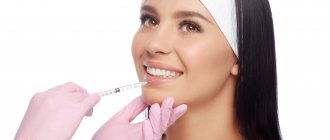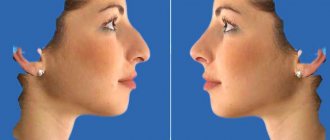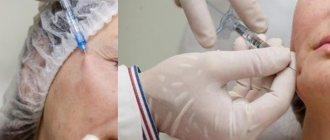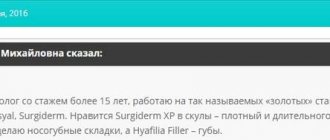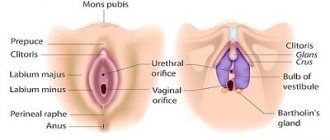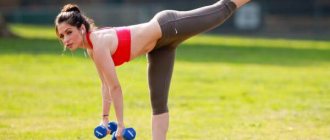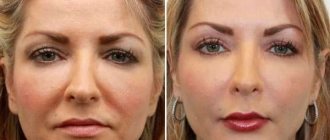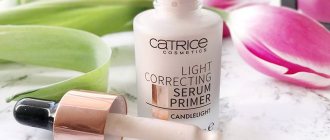Preparation
Before undergoing rhinoplasty, it is recommended to avoid the use of medications and nasal drops for three months before surgery, as many of them can interfere with the healing process after surgery.
If they are still used, then it is necessary to notify the attending physician about this. You should also not take any medications without consulting your doctor. Some medications may interact unfavorably with drugs used for anesthesia and anesthesia. It is necessary to stop smoking for 4 weeks before and after rhinoplasty (in some cases for a longer period, as determined by the doctor).
Process
Depending on the complexity of the operation, either general anesthesia or local anesthesia is chosen. Before the operation, the skin of the nose is disinfected, markings are made, and depending on the problem being solved, the operation is performed either openly or through intranasal incisions. Upon completion of the operation, cosmetic sutures are applied, to ensure the immobility of the new forms and to prevent swelling, cotton or gauze swabs are inserted into the nasal cavity, and the nose itself is also fixed with a special bandage. The duration of the operation ranges from 30 minutes to 2 hours, depending on the amount of work. The doctor determines the method of surgical intervention (open or closed) during the preoperative examination. In open surgery, a small incision is made in the vestibule of the nose and in the columella, the partition of skin between the nostrils; when closed - inside the nose. In the first case, the sutures will subsequently need to be removed, in the second - not, since absorbable material will be used.
Many patients, even having decided to change the tip of the nose with rhinoplasty, do not realize how much the result changes the features of the entire face. Despite the large number of plastic surgery clinics in Moscow, not every specialist undertakes rhinoplasty to correct the tip of the nose. This is due to the complexity of the operation and difficulties in obtaining the expected result. The doctors at the Correct Center have sufficient experience, so there are no barriers to their professionalism.
Rhinoplasty of this type is used to make the following types of correction of the tip of the nose.
- Decrease. The result is obtained by shortening the legs on the sides, dissecting the median and lateral cartilaginous legs and gunning the notches. The last stage is stretching the tissues of the external passages and narrowing the nostrils.
- Enlargement or lengthening. To achieve the “ideal projection” effect, the surgeon combines the middle cartilaginous legs with the lateral ones and narrows the dome wings on the cartilages. In some cases, biotransplantate obtained from the patient’s own cartilage tissue is used.
- Narrowing. The specialist connects the legs of the lateral lower cartilages and installs a biotransplant. As a result, the nose takes on a pointed shape.
- Redeployment. In order to lower or raise the tip of the nose, the surgeon connects the lateral median legs from below and fixes them with a jumper in the desired position.
For minor defects, contour plastic surgery can be performed, which involves non-surgical correction by injecting hyaluronic acid into the desired area. The price for non-surgical rhinoplasty of the tip of the nose in Moscow depends on the volume of correction zones.
Rhinoplasty of the tip of the nose - stages
The doctor's consultation. At the preliminary consultation, the doctor and the patient discuss the client’s wishes in detail.
Some have a forked nose, some have a round and fleshy nose, some have a sharp tip of the nose. How to fix? The doctor examines the tissues of the nose, evaluates the proportions of the face and nose and explains to the patient the possibilities and optimal options for rhinoplasty in each individual case. Having reached a consensus, they begin to plan the operation.
Examination. The patient undergoes a preliminary standard preoperative examination (blood tests for hepatitis B and C, HIV, syphilis, determination of blood group and Rh factor, ECG, fluorography, etc.).
Operation. It is performed under general anesthesia or local anesthesia. The choice of pain relief method depends on many factors - the volume of the planned intervention, the general condition of the body, the wishes of the patient, etc. Nasal tip surgery, like other types of rhinoplasty, can be performed using a closed or open surgical approach.
When open, the incision is made along the inner edge of the nostrils and the columella, a strip of skin at the bottom of the nose between the nostrils. After healing, traces of the operation are almost invisible. Open access gives the surgeon the opportunity to visually assess the condition and volume of soft tissue and cartilage.
When closed , the incision goes along the inner edge of the nostrils, that is, there are no seams on the outside at all.
Having peeled off the skin, with pinpoint precision the surgeon excises excess soft tissue and cartilage, literally reshaping them, connecting them in a new way, applying sutures, adjusting the shape. If it is necessary to add volume, a cartilage biotransplant is used.
Features of the operation
Depending on the purpose of nose tip correction, the surgical process may vary. So, in contrast to the correction of the internal nasal septum, local anesthesia is used during tip plastic surgery, which facilitates the rehabilitation process.
Features of plastic correction of the tip of the nose also include:
- the procedure is performed after 18 years of age, but for medical reasons surgery is possible in childhood;
- the result of plastic surgery may affect nasal breathing;
- the procedure has contraindications;
- it is possible to perform the operation using the laser method;
- It is permissible to use a graft made from cartilage tissue from the patient’s ribs.
The plastic surgeon informs the patient about all the features of nasal tip rhinoplasty before the operation. Also, despite the safety of plastic surgery, complications due to the individual reaction of the body, hidden contraindications or non-compliance with recommendations cannot be completely excluded.
Where to do rhinoplasty?
“European Clinic of Dr. Savinkov” is one of the flagships in endoscopic nasal surgery for both aesthetic and functional (FESS surgery) indications.
Rhinoplasty specialists, rhinologist surgeons and medical staff of the clinic constantly improve and maintain their professional level, offering their patients treatment at the level of the best world standards. We operate on patients from Chelyabinsk, Moscow, Yekaterinburg, Magnitogorsk, Kurgan, Tyumen, Surgut, other cities of Russia, as well as from other countries (USA, England, Canada, Israel).
Results of our rhinoplasty operations:
If you are faced with the question “Should I have rhinoplasty?”, then you can make an appointment with a plastic surgeon who specializes in rhinoplasty operations.
Telephones in Chelyabinsk:
sign up for a consultation
chief surgeon,
Phone in Moscow:
Rehabilitation
The duration of the recovery period after rhinoplasty is on average six months; throughout the entire period, swelling of the tissues of the nose and face as a whole slowly resolves. For the first 1-3 days after surgery, the patient is under inpatient observation by clinic specialists and then discharged home, but under strict supervision. The fixation bandage must continue to be worn for at least 2 weeks after surgery. Throughout the entire recovery period, it is recommended not to abuse smoking and alcohol, avoid visiting the solarium, baths and saunas, sunbathing, drinking hot drinks and food; reduce physical activity as much as possible. Do not physically impact the nose (do not knead, massage, do not wear glasses). And the most important thing is to maintain your immunity as much as possible in order to prevent colds and runny nose, in particular.
In just 2-3 months you will see the main results of nose shape correction. Over the next 9 months, the skin will “tighten” and the contours of the nose may change by 0.5-2 mm. That is, the results of aesthetic surgery are assessed after a year.
Contraindications
- pregnancy
- lactation
- age up to 18 years
- diabetes
- acute viral diseases
- chronic and infectious diseases in the acute stage
- blood diseases
- poor blood clotting
- oncology
- heart and kidney failure
- tendency to form colloidal scars
- It is not advisable to have plastic surgery after 55–60 years
When changing the contours of your nose, remember that during the rehabilitation period you will have to change your usual rhythm of life.
We recommend staying in the hospital for 24 hours after surgery. And for patients who have undergone general anesthesia, this is necessary. We must oversee your recovery.
You should not drink alcohol for the first three to five days after surgery, as antibiotics must be taken to prevent inflammation.
You will need to wear a plaster or plastic cast for the first week. That is, you are unlikely to be able to go to work.
Sauna, steam bath, solarium and physical activity are contraindicated for a month, exposure to direct sunlight - for two.
Modern techniques
There are quite a few types of rhinoplasty; which technique will be used depends on the desired result. Each patient receives an individual approach, so in our center not a single procedure is performed according to absolute standards.
To correct the tip of the nose, the following techniques are used:
- grafting - used when it is necessary to increase the volume of the tip of the nose by installing a cartilage graft;
- reconstruction - used to eliminate defects resulting from previous rhinoplasty.
Regarding the methods of performing the operation, plastic surgeons use two methods: laser and instrumental (scalpel). Rhinoplasty of the tip of the nose using the laser method has many advantages, including painlessness, bloodlessness and absence of scars, even with open access. But it is not always possible to use a laser, so surgery using a scalpel still remains relevant.
Should I have rhinoplasty?
What do patients come to us for?
People who come to our clinic are usually concerned about one of the following aesthetic defects of the nose:
- large or small nose size;
- a hump on the nose or a defect on the bridge of the nose due to injury;
- saddle nose deformity;
- crooked nose;
- pointed, beak-shaped or wide and thick tip of the nose;
- wide nostrils.
All these defects can be corrected in our clinic.
More details
Nowadays, the proportions of the nose are measured and expressed in numbers. Look at the profile of a European-type person. An important parameter is the nasofacial angle (1). It is believed that it should be 28-30°. However, don't worry if this isn't the case for you. For the Venus de Milo with her straight nose, this angle is generally zero. The nasolabial angle (2) is also measured, the standard value of which is 105° in women and 90° in men, although it can change significantly with age: the nose, as a rule, becomes hooked.
The bridge of the nose should be located just above the eyelash line of the upper eyelid and protrude 9-14 mm forward beyond the eyelid line or be 4-6 mm deeper than the glabella line.
Of course, it is correct if the nostrils are symmetrical. They are separated by a septum called the columella. It should be 3-4 mm below the edge of the nostril. The ideal nose does not have to be completely straight. It is allowed if there is a small, barely noticeable hump and a slightly raised tip of the nose. Do you already want to have a perfect nose? Take your time. Facial parameters are not beauty. Not everything is so simple: I built it according to a ruler, and it was beautiful. Such a nose will only fit the same face, built according to the laws of the golden ratio. But you can’t put the entire head of an antique statue on yourself. But there is a way out. Any artist will say: in order for the whole (in this case, the face) to look harmonious, what is important is not the individual parts themselves, but the correct proportions and relationships between the parts. So for a large face - a larger nose, for a small face - a smaller one. A slightly upturned nose suits short women, but tall women don't need it. Even if we had such a crazy idea to give everyone a perfect nose, we wouldn’t succeed. No matter how hard we try, the noses will still turn out to be individual, let’s say more unique. It depends on the anatomical features of the face. Without exaggeration, we can say that each of us is concerned about how he looks. Nowadays, a person’s attractive appearance is perceived as a sign of his health and even success. Many professions require an attractive appearance - top models, flight attendants, secretaries, all those who have to represent and communicate with people. Sometimes your career depends on it. One can understand how much suffering and even tears a nose that is too big, or too fat, or hunchbacked, or snub-nosed can cause in a young girl... Such problems often give rise to complexes, a consciousness of one’s own inferiority. Therefore, if you are not satisfied with your nose, the only solution is a visit to an aesthetic surgeon.
“In order to decide on rhinoplasty or rhinoseptoplasty surgery, I recommend coming for a consultation with a rhinoplasty surgeon, doing modeling, seeing if the new nose “suits” you, weighing the pros and cons of aesthetic nose correction. It is advisable to conduct an endoscopic examination to see if breathing will worsen as a result of nose surgery. In addition, you need to pass all the tests necessary for surgical intervention (the list is in the “” section). Good test results are a guarantee of the safety of your rhinoplasty.”
